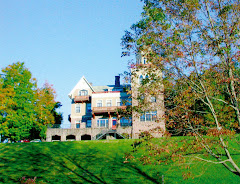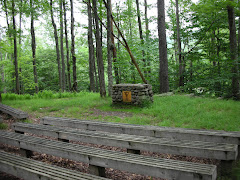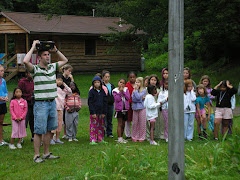This is what I wrote for the printed program participants received at the luncheon/ceremony yesterday at which we inducted into the FV Hall of Fame four people crucial to the development of Wawayanda, Hird and Frost Valley: Henry Hird, Bob Ohaus, and Carl & Marie Hess.
*
No one in the histories of Camp Wawayanda and Frost Valley
could be said to have felt a more abiding devotion to young people—and to the
very idea of camp—than Henry Edward Hird (1884-1983). As chairman of the New
Jersey YMCA he once pledged to visit every Y facility and camp in the state,
and indeed visited and spoke at 40 Y’s within three months. He knew everyone in
camping and avidly believed the camp experience to be what children crucially
needed for the development of independence, the capacity for true friendship,
and respect for the natural environment. As the son of Samuel and Rose Hird
(who are memorialized by Hird Lodge at Frost Valley and were for decades
honored by the name of the famously elaborate swimming docks at Old Wawayanda),
Henry also knew many in the world of woolen manufactury through his father’s
business, Samuel Hird & Sons. Julius Forstmann had advised Henry’s father
as he got his own business started, and the “next generation of Hirds and
Forstmanns,” as Henry’s son Floyd (himself a longtime Wawayanda trustee) once
put it, always had great respect for each other. And so it was Henry Hird who
found out that the Forstmann estate in the Catskills was for sale, and it was Henry,
along with Walter Margetts, who negotiated the deal on Christmas Eve of 1956 to
bring Camp Wawayanda to Frost Valley. Henry served as chair of the famed
“Wawayanda Committee” (or “Camp Committee”) of the camp’s board—and, with
Margetts, Ed Tomb, and others, he guided the camp in its fragile early years of
building program and facility and staff in our current extraordinary location.
When in 1961 the Board found the camp strapped for income,
and sensed, too, that Wawayanda’s constituency had narrowed and that the camp
could do more to reach more children, they made what might seem today to have
been an obvious inclusive decision—to open Camp Wawayanda to girls and women.
Seemingly obvious now, but given the famed six-decade-long tradition of a great
camp for boys, no one deemed this change to be simple or uncontroversial. Henry
Hird not only supported it but generously enabled the expansion of facilities
that would make what was first called “Camp Wawayanda for Girls” or “Girls’
Camp” a true camp in itself. Soon after twenty new cabins were constructed
above Lake Cole, and McLain Hall was built as a dining hall (now Geyer Hall)
for Girls’ Camp, the entire new camp was named in honor of our inductee: Camp
Henry Hird. Then, in 1983, beginning a three-year period when both camps dined
in McClain (due to the destruction by fire of Thomas Lodge), the decision was
made to divide the camps by age, at which point Camp Henry Hird became known
affectionately and proudly as “The Hird”—a co-ed camp for teens, both boys and
girls. This organization by age rather than gender in turn led the way for the
inclusion in Camp Hird of villages for 15-year-olds (“Cherokee,” “Sunburst,”
“Windsong” and “Quinnipiac”) and of Adventure Village (“Sequoia”) and finally
of “MAC” (for mainstreamed, intellectually disabled young adults). The new
traditions that had been quickly and powerfully established by girls and women
at camp starting in 1962—thoughtful devotions at night; beautiful all-camp
gatherings at campfires; three-part harmony singing in the dining hall after
lunch and dinner; time built into the daily schedule for reflection; a focus on
whole well-being; the highest value placed on friendship and acceptance—became
the hallmarks of Camp Henry Hird as a distinct community and, at the same time,
pervaded the Wawayanda and Frost Valley spirit overall, and this is what became
known as the “magic of Frost Valley.”
Far beyond what he could have imagined when he and Ed Tomb
toured the farms and barns and stone mansion of the Forstmann property, and far
beyond what he could have realized by raising his hand to affirm the inclusion
of girls and women, Henry Hird’s belief that camp was good for kids has had a
tremendous ripple effect. By inducting Henry Edward Hird into Frost Valley’s
Hall of Fame, we laud posthumously a generous supporter and keen steward of
Wawayanda and Y camping generally, but we also use this occasion to honor the
way in which acts of inclusion are inherently good. Hird’s advocacy of the idea
of serving more children inevitably
meant serving all kinds of children and indicated for all
of us who care about Frost Valley’s future the belief that we need never fear
new directions.











